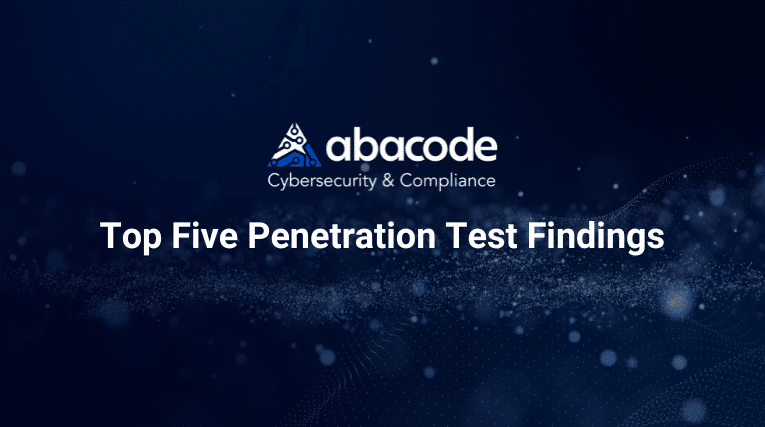Authored by Damian Roneker and Michael Mallen
Addressing Weaknesses Before Threat Actors Exploit Them
Organizations today face relentless attempts by cyber adversaries to exploit vulnerabilities across networks, systems, and applications. Proactively identifying and addressing these weaknesses must be a cornerstone of every organization’s cybersecurity strategy. Penetration testing, performed by qualified experts, replicates the tactics of real-world attackers to uncover hidden vulnerabilities — before they can be leveraged for credential theft, data breaches, or system compromise.
At Abacode, our SOC and Cyber Testing teams work alongside organizations to identify exploitable attack vectors and deliver actionable recommendations that strengthen overall security resilience.
In this post, our cyber experts share the top five recurring findings from recent penetration tests — combined with insight from industry threat intelligence — and practical, high-impact steps organizations can take to address them.
Local Administrator Credential Reuse
The Risk:
Local administrative accounts act as “master keys” to individual systems. Using the same credentials across multiple devices creates a significant risk: compromise one machine, and an attacker could move laterally across the network with ease.
The Attack Vector:
Threat actors often use an “Identity Snowball” technique — compromising one account and chaining that access to escalate privileges across the environment, potentially gaining control of domain admin accounts.
Recommendations to Mitigate:
It is one of the principles of Zero Trust approach to provide the least privileged access, meaning only provisioning local administrative rights to users who absolutely need it. Another solution that may be overlooked, or one that most organizations struggle to consider more closely as a first line of defense, is to ensure that all administrative accounts use unique passwords for each asset. Even if an account were compromised, unique passwords ensure the compromised account cannot be used for further attacks. One way this can be accomplished is by implementing Microsoft’s local account management solution “LAPS” (Local Administrator Password Solution). Abacode is a Designated Solutions Partner for Security with Microsoft. Learn more about how we help improve security and consolidate costs through Microsoft here.
Internet-Exposed Login Pages
The Risk:
Web-based admin interfaces and remote access portals, if exposed directly to the internet, present easily discoverable attack surfaces.
The Attack Vector:
Compromised credentials — often obtained through phishing — can be used to log in via exposed SSL VPN portals or remote gateways, establishing a persistent foothold in the network.
Recommendations to Mitigate:
Review the various login portals and their settings and determine the business need for each protocol to be accessible to the internet. For example, if an organization has an SSL VPN portal open to the outside internet, a more secure method would be to only have the login portal accessible via certificate authentication pre-installed on user’s workstations, limiting the attack surface.
If remote administration via these access methods is needed specifically and no business compromise can be met, some recommendations include:
- Use an Authentication Policy that enforces multi-factor authentication (MFA).
- Use preconfigured VPN agent clients and disable the SSL VPN self-service portal.
- Follow the recommendations from the National Institute of Standards and Technology in their special publication SP 800-77.
Last, reducing direct login exposure dramatically decreases the attack surface available to adversaries.
LLMNR/mDNS Poisoning and SMB Relay Attacks
The Risk:
Legacy name resolution protocols like LLMNR and NetBIOS can be hijacked by attackers to spoof devices and intercept network authentication traffic — an attack known as Adversary-in-the-Middle (AiTM).
The Attack Vector:
By poisoning local network traffic, threat actors can steal user credentials or relay them to access other systems.
Recommendations to Mitigate:
- Disable LLMNR and NetBIOS in local computer security settings or by group policy if they are not needed within an environment.
- Use host-based security software to block LLMNR/NetBIOS traffic. Enabling SMB Signing can stop NTLMv2 relay attacks.
- Network intrusion detection and prevention systems that can identify traffic patterns indicative of AiTM activity can be used to mitigate activity at the network level.
- Network segmentation can be used to isolate infrastructure components that do not require broad network access. This may mitigate, or at least alleviate, the scope of AiTM activity.
Operational Security (OPSEC) Issues: Clear Text Credentials
The Risk:
Credentials or sensitive information stored in plain text — in documents, emails, file shares, or messaging apps — provide low-hanging fruit for attackers post-compromise.
The Attack Vector:
Attackers who gain even limited access can quickly search systems, mailboxes, and collaboration platforms for unprotected passwords or confidential data.
Recommendations to Mitigate:
- Implement regular security awareness training focused on OPSEC fundamentals.
- Prohibit saving credentials in plain text (e.g., Notepad files or email drafts).
- Adopt password vaults or Privileged Access Management (PAM) solutions to securely store sensitive credentials.
- Audit historical projects and documentation for exposure of sensitive data.
- Human behavior remains the largest variable in cybersecurity. Building a culture of operational discipline is critical.
Default Configurations and Credentials
The Risk:
Many off-the-shelf (COTS) network devices and applications ship with default usernames and passwords — often widely known and searchable online.
The Attack Vector:
Attackers exploit these default credentials to gain administrative access to systems, applications, and underlying databases.
Recommendations to Mitigate:
- Review and harden default settings for all systems and devices immediately upon deployment.
- Consult vendor documentation and advisories for any known default accounts.
- Monitor authentication logs for suspicious use of default credentials.
- Default settings are designed for ease of installation — not for security. Organizations must close these “built-in” backdoors as part of their standard system hardening procedures.
Final Thoughts
Penetration testing is not just a checkbox for regulations — it’s a critical diagnostic tool for improving your cybersecurity posture, uncovering the attack vectors you did not know existed within your infrastructure.
Understanding these top findings helps organizations make meaningful steps toward a more secure, Zero Trust-aligned environment to protect business operations and customer trust.
Abacode’s Cyber Testing Team stands ready to help your organization identify risks and remediate vulnerabilities before attackers can exploit them. Connect with us to learn how a proactive, risk-based cybersecurity program can accelerate your business securely into the future.



